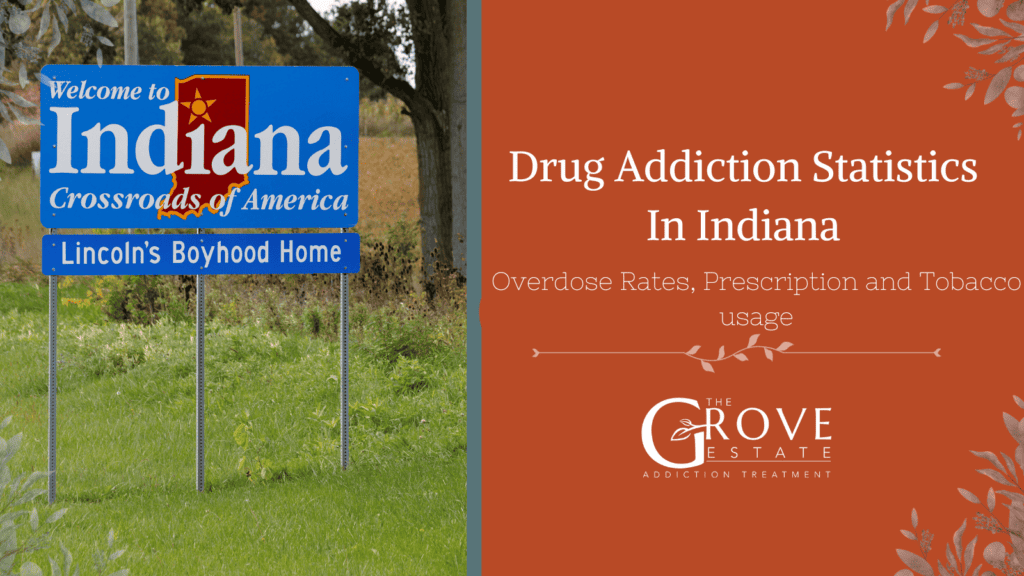Drug use and addiction are significant concerns in the state of Indiana. Issues stemming from drug abuse encompass a range of substances–from opioids and methamphetamines to other illicit drugs. Indiana has grappled with the consequences of substance misuse, witnessing fluctuations in addiction rates, overdoses, and related fatalities over recent years.
Here are some facts you need to know about the state’s drug abuse and addiction problems:
KEY TAKEAWAYS:
- 2,811 individuals from Indiana succumbed to drug overdoses in 2021, with synthetic opioids like fentanyl contributing to over 70% of these fatalities.
- The overall drug overdose death rate rose from 15.3 per 100,000 in 2011 to 43 per 100,000 in 2021.
- In 2021, 44.1% of Hoosiers aged 12 and older reported current alcohol use, while the age-adjusted alcohol-attributable mortality rate in Indiana was 14.8 per 100,000 population.
- In 2021, 23.8% of Hoosiers age 12 and older reported current tobacco use.
- In 2021, 11.7% of Hoosiers age 12 and older reported current marijuana use, with a higher incidence observed among young adults (18 to 25 years old) at 25.5% reporting past-month use.
- In the 2021 survey, approximately 1.5% of Hoosiers aged 12 and older reported misusing prescription pain relievers in the prior year. Additionally, the data revealed that around 0.3% of individuals aged 26 and older in Indiana used heroin in the past year, 1.5% reported using cocaine, and 1.0% reported using methamphetamine in the previous year, according to the 2021 NSDUH data.
- 80% of Indiana’s employers have witnessed prescription drug misuse among their employees.
- Indiana’s emergency departments handle over 600,000 yearly visits for non-fatal poisonings, with 90% linked to drug abuse.
General Insights
Indiana is struggling with a huge issue: drug misuse is skyrocketing, causing a spike in overdose deaths. This issue has led various government bodies, healthcare professionals, and community groups to work together, aiming to tackle prevention, treatment, and recovery programs designed to meet the unique needs of Indiana’s diverse population.
- Physicians in Indiana wrote 65.8 opioid prescriptions for every 100 individuals in 2018. This rate surpassed the average U.S. rate of 51.4 prescriptions per 100 people.
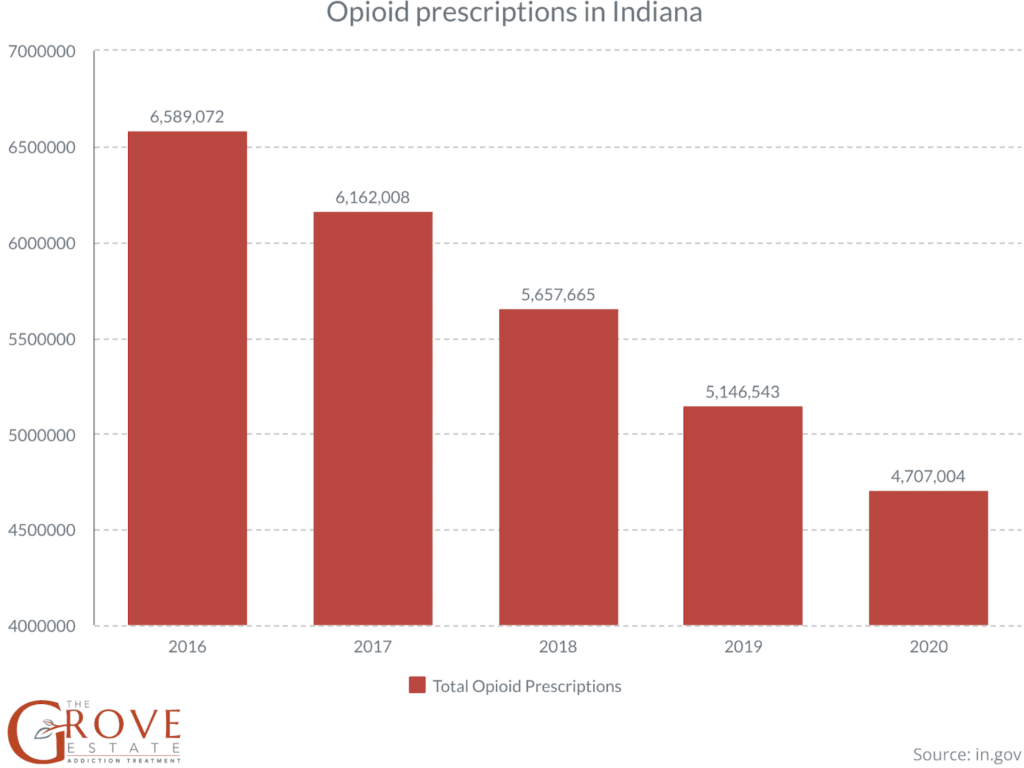
- Around 9% of Indiana residents used illicit drugs in the past month. This rate is slightly higher than the national average of 8.8%.
- At the same time, 3.7% of residents reported recent use of illicit drugs excluding marijuana. This is slightly above the national average of 3.3%.
- Between 2011 and 2015, Indianapolis Emergency Management Services observed a significant surge, with a 117% increase in the volume of calls received. Similarly, during this timeframe, the Indianapolis Metropolitan Police Department encountered a remarkable uptick of 306% in calls specifically related to narcotics.
- Within Indiana’s incarcerated population, 53% have been diagnosed with a substance use disorder. Furthermore, among those who return to prison, a staggering 75% have a history of substance abuse disorder, highlighting the prevalence and impact of addiction within the criminal justice system.
- In 2021, 2,811 individuals from Indiana succumbed to drug overdoses, with synthetic opioids like fentanyl contributing to over 70% of these fatalities. This statistic underscores the significant impact of substances like fentanyl on the rising overdose deaths in the state. (U.S. Attorney’s Office, Southern District of Indiana)
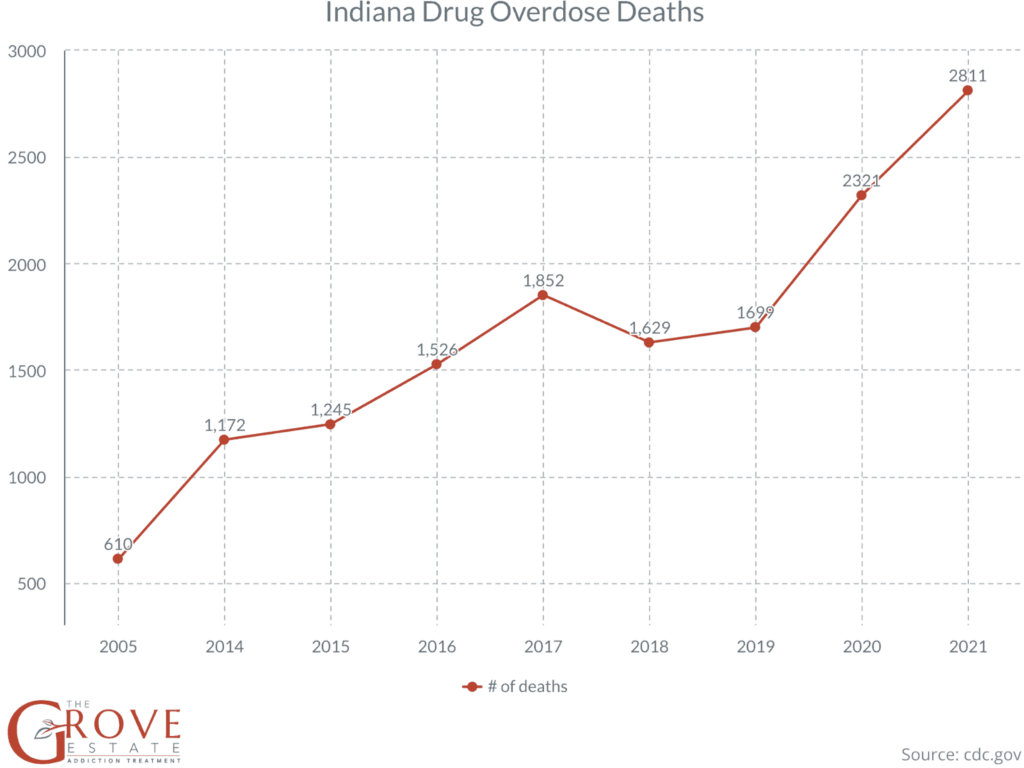
- Among Indiana youth, prescription drug misuse (PDM) was reported by 3% of non-Hispanic Black, 4% of non-Hispanic White, and 5% of Hispanic students, with early onset of smoking linked to PDM across all groups. Among Hispanic students, the start of drinking correlated with initial PDM, while for non-Hispanic Black and non-Hispanic White students, PDM tendencies were most noticeable in very early adolescence.
- Indiana has a 3.15% prevalence rate of pain reliever misuse among individuals aged 12 or older in 2021. This prevalence rate is lower compared to 4.92% between 2015 and 2016.
- In 2021, 44.1% of Hoosiers aged 12 and older reported current alcohol use. This marked a decrease of 4.3 percentage points from the previous year.
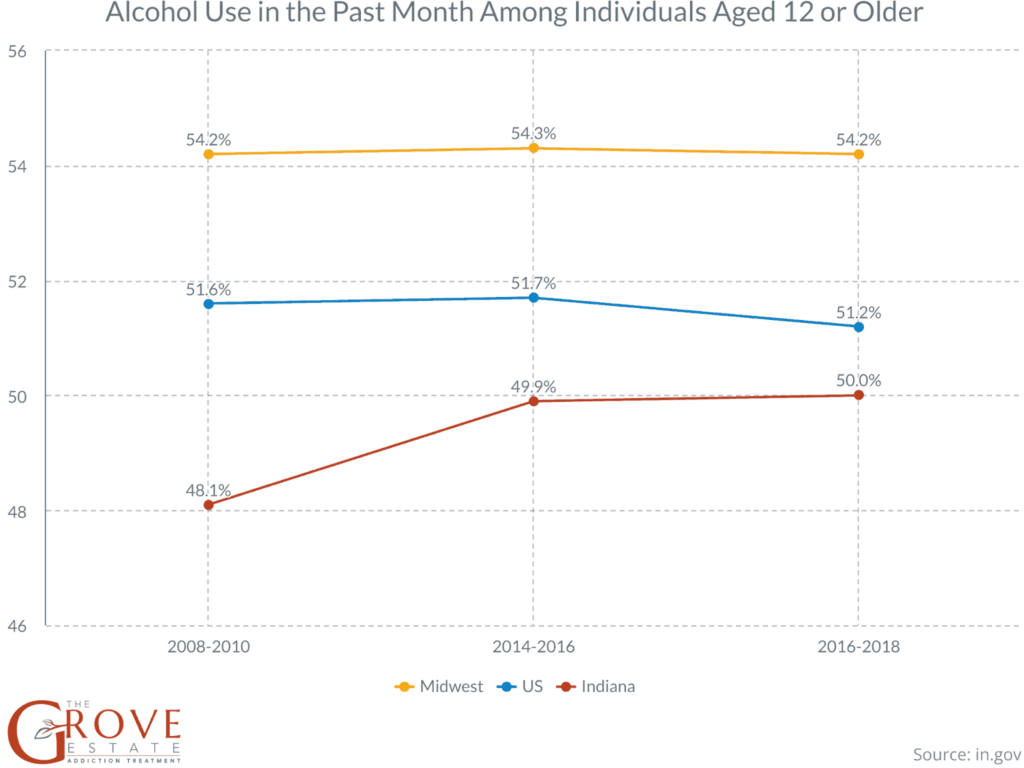
- In the same year, adult alcohol use saw a slight increase to 51.9%. This marks a rise of 0.8 percentage points from the previous year.
- In the same data, 55.4% of men reported using alcohol in the past month, showing a decrease of 0.7 percentage points from the prior year. Women showed an increase to 46.1%, marking a rise of 1.9 percentage points from the previous year.
- In 2022, approximately 48.6% of total treatment episodes included reported marijuana use as a primary, secondary, or tertiary substance, indicating a 1.5 percentage point increase from the previous year. Of these episodes, 18.8% reported marijuana as the primary substance, reflecting a 0.7 percentage point increase from the previous year.
- Indiana’s opioid dispensation rate in the third quarter of 2022 was 178.4 per 1,000 population, indicating a decrease of 0.5 points from the rate recorded during the period last year. This rate includes opioid analgesics, opioid antidiarrheal/antitussives, opioid antagonists, and addiction treatment medications.
- In 2021, 23.8% of Hoosiers aged 12 and older reported current tobacco use.
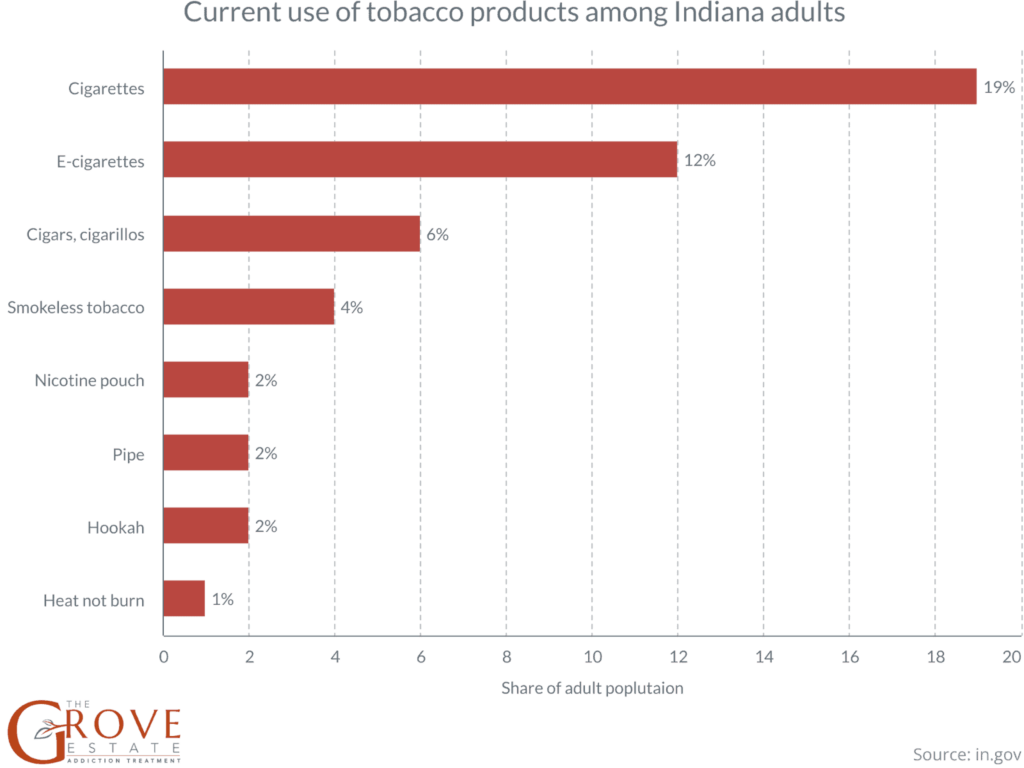
- In a 2021 survey, approximately 1.5% of Hoosiers aged 12 and older reported misusing prescription pain relievers in the prior year, showing a decrease of 1.8 percentage points from the preceding year.
- Around 16.8% of total treatment admissions included reported opioid use as a primary, secondary, or tertiary substance, indicating a 0.7 percentage point increase from the previous year. Among these admissions, 7.4% reported opioids as the primary substance, marking a 0.4 percentage point increase from the prior year.
- In the same survey, approximately 0.3% of Indiana’s population aged 26 and older reported using heroin in the past year.
- Indiana, ranking 15th in the nation with 1152 overdose deaths in 2014, has seen a staggering increase of over 500% in drug overdose fatalities since 1999. This rise reflects a dramatic surge in the number of deaths attributed to drug overdoses within the state.
- In 2022, among all treatment admissions, 21.8% reported heroin use as a primary, secondary, or tertiary substance, marking a decrease of 1.1 percentage points from the previous year. Specifically, 14.7% of episodes cited heroin as the primary substance, reflecting a decrease of 1.4 percentage points from the prior year.
- Alcohol is the predominant substance used by college students in both Indiana (55.6%) and the United States (55.7%). Following alcohol, the next commonly used substances are marijuana (Indiana: 21.3%; United States: 24.5%) and electronic vapor products (Indiana: 21.6%; United States: 23.9%).
- Hallucinogens are reported at a similar rate in both Indiana (2.4%) and the United States (2.4%). Cocaine use is slightly lower in Indiana (1.1%) compared to the national rate (1.4%). However, for prescription sedatives not prescribed to the user, inhalants, prescription painkillers not prescribed to the user, methamphetamine, heroin, and other illegal drugs, Indiana’s reported rates are lower compared to national statistics.

- Of the students who use cocaine, a notably high percentage—67.1%—began using it after they started college. This marks the highest percentage compared to the onset of use for other reported substances.
- In 2022, a notable 34.8% of Hoosiers who sought substance use treatment reported using opioids—including heroin, non-prescription methadone, and other opiates/synthetics—as a primary, secondary, or tertiary substance.
- On June 13, 2023 the state revealed over $76 million in new funding for crisis response and substance use disorder services. This allocation also aims to bolster initiatives aiding Hoosiers by enhancing mental health and recovery services.
Effects of Substance Misuse
Substance misuse can lead to a lot of problems. From health struggles to social challenges, the effects ripple through lives, affecting well-being and relationships in profound ways.
- In 2014, Indiana recorded 657 cases of NAS (Neonatal Abstinence Syndrome) in newborns, demanding extensive and costly hospital care after birth. The incidence of NAS nationally tripled from 2000 to 2009, leading to symptoms such as irritability, tremors, and respiratory distress in infants exposed to opioids in utero.
- Indiana experienced a rise of 30% in the influx of children entering the welfare system in 2013, largely attributed to parental substance abuse. Similarly, Marion County Juvenile Court observed a notable surge in children removed from homes and put under protective care owing to parental addiction, while instances of parental rights termination increased by 31% during that period.
- The overall drug overdose death rate rose from 15.3 per 100,000 in 2011 to 43 per 100,000 in 2021. During the same period, the U.S. saw an increase from 13.2 to 32.4 deaths per 100,000 due to drug overdoses.
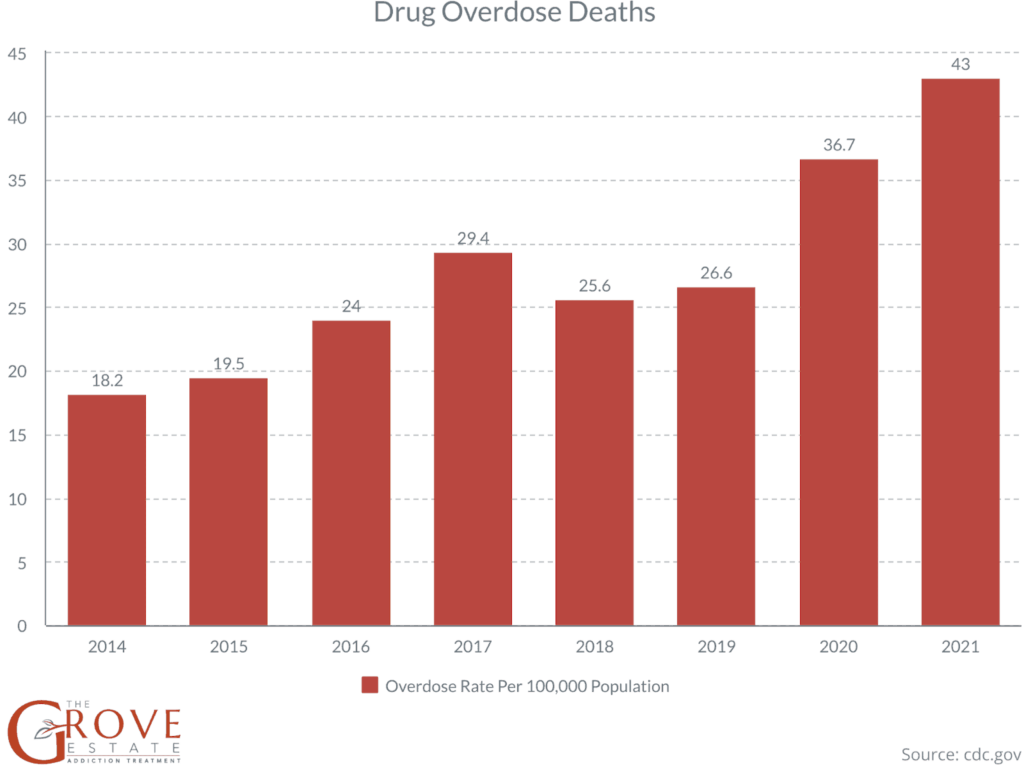
- In 2020, opioid-involved drug poisoning deaths in Indiana reached 27.8 per 100,000 people, showing a significant increase from 2013 when the rate was 5.3 per 100,000 people.
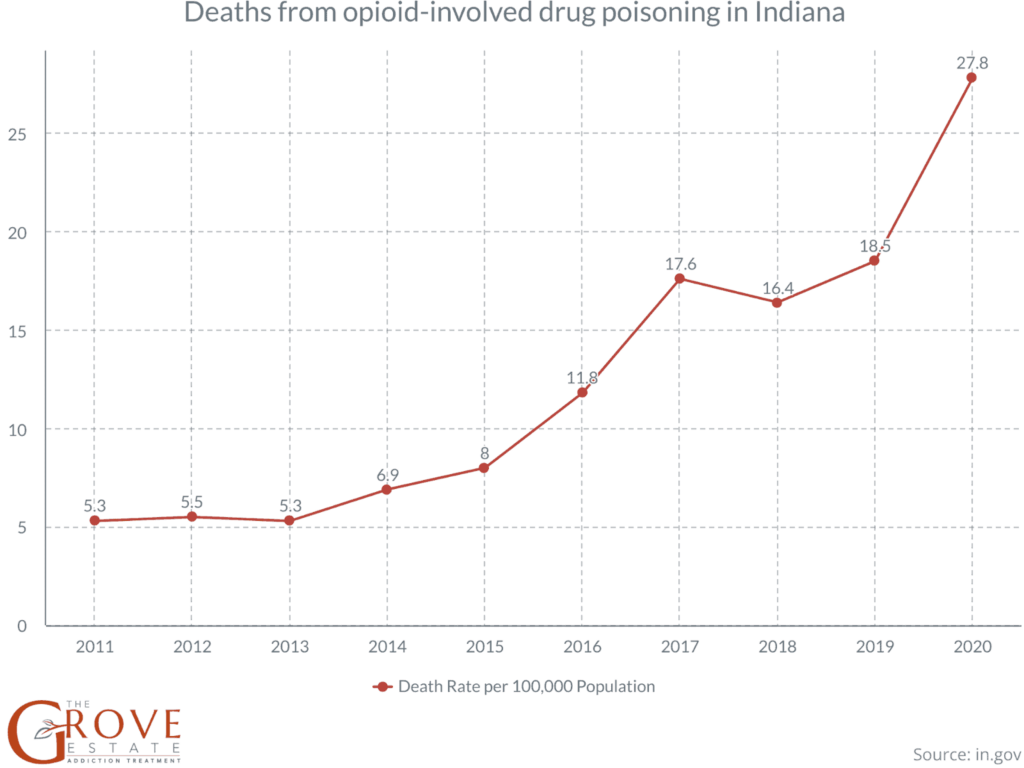
- Between January 1 and August 1, 2022, over 2,500 lives in Indiana were lost to drug overdoses. The vast majority of these tragic deaths were attributed to fentanyl and similar drugs. (U.S. Attorney’s Office, Southern District of Indiana)
- Up to 80% of people who engage in injection drug use may contract HIV, hepatitis B, or hepatitis C through needle sharing. This risk of viral transmission arises among individuals injecting opioids or heroin, highlighting the concerning impact within five years of initiating this practice.
- Eighty percent of Indiana’s employers have witnessed prescription drug misuse among their employees. This prevalence underscores the concerning impact of this issue within the state’s workforce.
- About 64% of employers perceive prescription drugs as a more significant issue in the workplace than illegal substances. This perception highlights a concerning trend in how these drugs impact the work environment.
- Indiana’s emergency departments handle over 600,000 yerly visits related to non-fatal poisonings, with 90% stemming from drug abuse. These Emergency Department (ED) visits were specifically due to the abuse of opioids and heroin.
County Statistics
Many counties across the state, particularly Marion & Hamilton, grapple with soaring rates of drug-related emergencies. In these places, drug overdose deaths, particularly linked to opioids, remain a significant concern.
Marion
- The Marion County Coroner’s Office (MCCO) examined 1,409 accidental deaths. Among these cases, accidental drug intoxication was the primary cause in 801 instances. This indicates its significant prevalence among the investigated fatalities.
- More than $1 million from the Indiana Opioid Settlement funds has been given the green light for distribution to the MCCO. This allocation aims to support initiatives targeting substance use disorder and mental health challenges affecting Marion County residents.
Accidental Deaths by Cause, Marion County, 2022
| Cause of Death | Total | Percentage |
| Drug Intoxication | 801 | 57% |
| Blunt Force | 483 | 34% |
| Fire/Thermal | 27 | 2% |
| Drug Use Contrib ** | 21 | 1% |
| Asphyxiation | 19 | 1% |
| Drowning | 17 | 1% |
| Choking | 12 | 1% |
| Environmental | 11 | 1% |
| Other | 7 | 0.50% |
| Carbon Monoxide | 5 | 0.40% |
| Anaphylaxis | 4 | 0.30% |
| Gunshot Wound | 2 | 0.10% |
| Total | 1,409 | 100% |
- ** Drug use was additionally identified as a contributing factor in approximately 1% more cases, extending its role in contributing to the cause of death beyond the primary instances of drug intoxication.
- About 69% of drug intoxication death cases in Marion County are males and 31% are females. The county saw a 1% decline in males from the prior year but observed a 1% increase in females.
- There were 801 accidental drug intoxication cases in 2022. In 2021, there were only 799 cases, and 640 cases in 2020. The accidental drug intoxication trend in Marion County has been going up consistently.
- About 64% of drug intoxication cases in 2022 were made up of White and 35% were Black. Black decedents increased by 6% from 2021.
- The year 2022 revealed a rise in fatalities caused by drug intoxication among those aged 50 to 79. This uptick signals a worrying prevalence of illicit substance abuse within the elderly population, highlighting ongoing concerns about substance misuse among older residents.
- The 30-39 age group has the most fatalities in 2022 at 215 cases. This is followed by the 40-49 age group (177 deaths), 50-59 age group (166 deaths), 20-29 age group (129 deaths), 60-69 age group (89 deaths), 70-79 & 13-19 age group (11 deaths), and 80-89 age group (2 deaths).
- Among the 801 cases, 62% of individuals have a history of illicit substance abuse and 14% don’t. The history is unknown for the 24%, however.
- Coroners identified 21 cases where illicit drug use or a positive drug screen directly contributed to the death but was not the immediate significant cause of the death. The primary cause for most of these cases is cardiac issues.
Hamilton County
- The Hamilton County Drug Court has 131 men and 57 women as participants. The Hamilton County Drug Court was established in 2010 and is one of several problem-solving court models available in Indiana.
- In 2019, about 20% of Hamilton County residents were categorized as excessive alcohol consumers, slightly above the state’s average of 18%. Additionally, 21% of driving-related deaths in Hamilton County were attributed to alcohol-impaired drivers, just above the state’s average of 20%.
- In 2018, there were 874 admissions for substance abuse treatment in Hamilton County, with 63% of the clients identifying alcohol as their primary drug of choice.
- Out of 716 juveniles referred to Probation in 2019, 36% of the total cases were connected to drug or alcohol-related offenses, with possession of marijuana accounting for 239 cases and possession of alcohol for 120 cases. Additionally, there were six OWI offenses, ten cases of dealing marijuana, and nineteen cases related to possession or dealing of controlled substances among these referrals.
- Hamilton County recorded 118 juvenile marijuana offenses, while adult marijuana offenses totaled 762 in 2019.
- At the same time, adult possession or dealing of controlled substance offenses reached 1,245, with 40 adult misdemeanor charges related to Operating While Intoxicated (OWI) involving Schedule I or II controlled substances.
FAQs
What is the current status of drug overdose deaths in Indiana?
Indiana has experienced a stark increase in drug overdose fatalities, witnessing a surge of over 500% since 1999. In 2021 alone, 2,554 individuals in Indiana succumbed to drug overdoses, notably attributed to synthetic opioids like fentanyl, contributing to over 70% of these fatalities.
What’s the prevalence of substance use disorders within Indiana’s incarcerated population?
Within Indiana’s incarcerated population, 53% have been diagnosed with a substance use disorder. Remarkably, 75% of individuals returning to prison have a history of substance abuse disorder, emphasizing the prevalence and impact of addiction within the criminal justice system and the need for addiction treatment.
What has been the trend in drug overdose deaths in Indiana compared to the national average?
The drug overdose death rate in Indiana surged from 15.3 per 100,000 in 2011 to 43 per 100,000 in 2021. Similarly, the U.S. witnessed an increase from 13.2 to 32.4 deaths per 100,000 due to drug overdoses during the same period.
How have opioid-related poisoning deaths evolved in Indiana over the years?
The rate of drug poisoning deaths involving any opioid in Indiana per 100,000 residents remained consistent from 2011 (5.3) to 2013 (5.3). However, a noticeable increase began in subsequent years, highlighting the concerning trend of opioid-related fatalities.
How prevalent is prescription drug misuse in Indiana’s workforce?
A staggering 80% of Indiana’s employers have reported witnessing prescription drug misuse among their employees, signaling the concerning impact of this issue within the state’s workforce.
Where to get help for addiction in Indiana?
If you or a loved one are struggling with substance use disorder, there are luxury drug rehab centers in Indiana as well as dual diagnosis and free rehab centers. Contact us today to get help!
SOURCES
- in.gov
- purdue.edu
- obamawhitehouse.archives.gov
- fsph.iupui.edu
- justice.gov
- indy.gov
- pubmed.ncbi.nlm.nih.gov
- datatools.samhsa.gov

Share This Post
